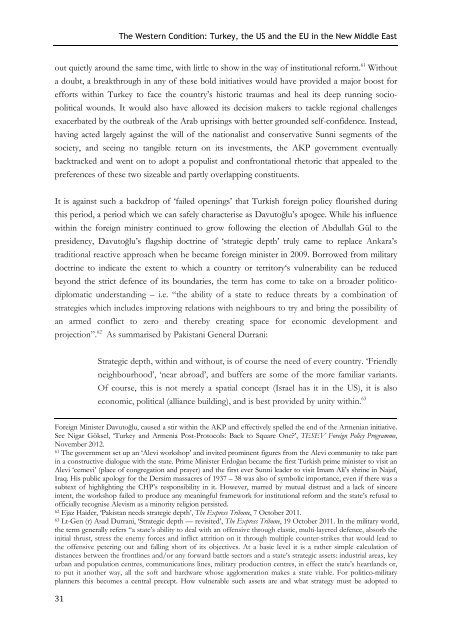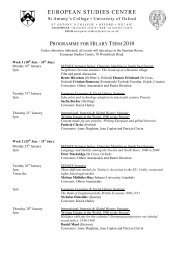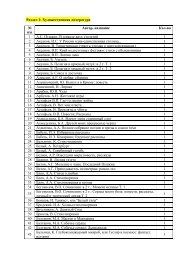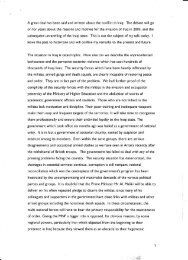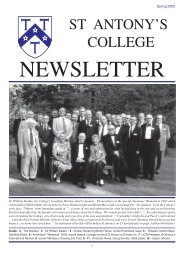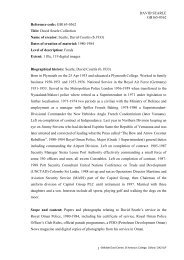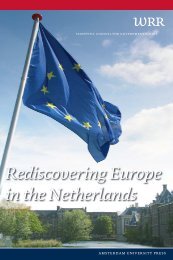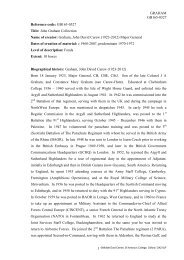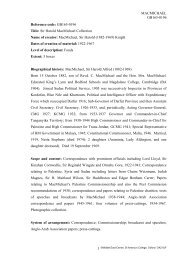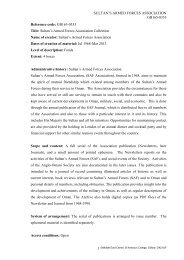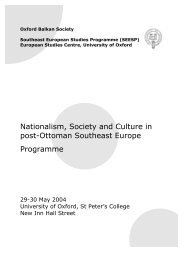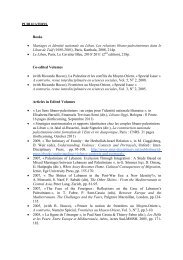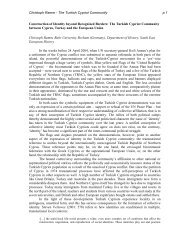The Western Condition - St Antony's College - University of Oxford
The Western Condition - St Antony's College - University of Oxford
The Western Condition - St Antony's College - University of Oxford
You also want an ePaper? Increase the reach of your titles
YUMPU automatically turns print PDFs into web optimized ePapers that Google loves.
<strong>The</strong> <strong>Western</strong> <strong>Condition</strong>: Turkey, the US and the EU in the New Middle East<br />
out quietly around the same time, with little to show in the way <strong>of</strong> institutional reform. 61 Without<br />
a doubt, a breakthrough in any <strong>of</strong> these bold initiatives would have provided a major boost for<br />
efforts within Turkey to face the country’s historic traumas and heal its deep running sociopolitical<br />
wounds. It would also have allowed its decision makers to tackle regional challenges<br />
exacerbated by the outbreak <strong>of</strong> the Arab uprisings with better grounded self-confidence. Instead,<br />
having acted largely against the will <strong>of</strong> the nationalist and conservative Sunni segments <strong>of</strong> the<br />
society, and seeing no tangible return on its investments, the AKP government eventually<br />
backtracked and went on to adopt a populist and confrontational rhetoric that appealed to the<br />
preferences <strong>of</strong> these two sizeable and partly overlapping constituents.<br />
It is against such a backdrop <strong>of</strong> ‘failed openings’ that Turkish foreign policy flourished during<br />
this period, a period which we can safely characterise as Davutoğlu’s apogee. While his influence<br />
within the foreign ministry continued to grow following the election <strong>of</strong> Abdullah Gül to the<br />
presidency, Davutoğlu’s flagship doctrine <strong>of</strong> ‘strategic depth’ truly came to replace Ankara’s<br />
traditional reactive approach when he became foreign minister in 2009. Borrowed from military<br />
doctrine to indicate the extent to which a country or territory‘s vulnerability can be reduced<br />
beyond the strict defence <strong>of</strong> its boundaries, the term has come to take on a broader politicodiplomatic<br />
understanding – i.e. “the ability <strong>of</strong> a state to reduce threats by a combination <strong>of</strong><br />
strategies which includes improving relations with neighbours to try and bring the possibility <strong>of</strong><br />
an armed conflict to zero and thereby creating space for economic development and<br />
projection”. 62 As summarised by Pakistani General Durrani:<br />
<strong>St</strong>rategic depth, within and without, is <strong>of</strong> course the need <strong>of</strong> every country. ‘Friendly<br />
neighbourhood’, ‘near abroad’, and buffers are some <strong>of</strong> the more familiar variants.<br />
Of course, this is not merely a spatial concept (Israel has it in the US), it is also<br />
economic, political (alliance building), and is best provided by unity within. 63<br />
Foreign Minister Davutoğlu, caused a stir within the AKP and effectively spelled the end <strong>of</strong> the Armenian initiative.<br />
See Nigar Göksel, ‘Turkey and Armenia Post-Protocols: Back to Square One?’, TESEV Foreign Policy Programme,<br />
November 2012.<br />
61 <strong>The</strong> government set up an ‘Alevi workshop’ and invited prominent figures from the Alevi community to take part<br />
in a constructive dialogue with the state. Prime Minister Erdoğan became the first Turkish prime minister to visit an<br />
Alevi ‘cemevi’ (place <strong>of</strong> congregation and prayer) and the first ever Sunni leader to visit Imam Ali’s shrine in Najaf,<br />
Iraq. His public apology for the Dersim massacres <strong>of</strong> 1937 – 38 was also <strong>of</strong> symbolic importance, even if there was a<br />
subtext <strong>of</strong> highlighting the CHP’s responsibility in it. However, marred by mutual distrust and a lack <strong>of</strong> sincere<br />
intent, the workshop failed to produce any meaningful framework for institutional reform and the state’s refusal to<br />
<strong>of</strong>ficially recognise Alevism as a minority religion persisted.<br />
62 Ejaz Haider, ‘Pakistan needs strategic depth’, <strong>The</strong> Express Tribune, 7 October 2011.<br />
63 Lt-Gen (r) Asad Durrani, ‘<strong>St</strong>rategic depth — revisited’, <strong>The</strong> Express Tribune, 19 October 2011. In the military world,<br />
the term generally refers “a state’s ability to deal with an <strong>of</strong>fensive through elastic, multi-layered defence, absorb the<br />
initial thrust, stress the enemy forces and inflict attrition on it through multiple counter-strikes that would lead to<br />
the <strong>of</strong>fensive petering out and falling short <strong>of</strong> its objectives. At a basic level it is a rather simple calculation <strong>of</strong><br />
distances between the frontlines and/or any forward battle sectors and a state’s strategic assets: industrial areas, key<br />
urban and population centres, communications lines, military production centres, in effect the state’s heartlands or,<br />
to put it another way, all the s<strong>of</strong>t and hardware whose agglomeration makes a state viable. For politico-military<br />
planners this becomes a central precept. How vulnerable such assets are and what strategy must be adopted to<br />
31


